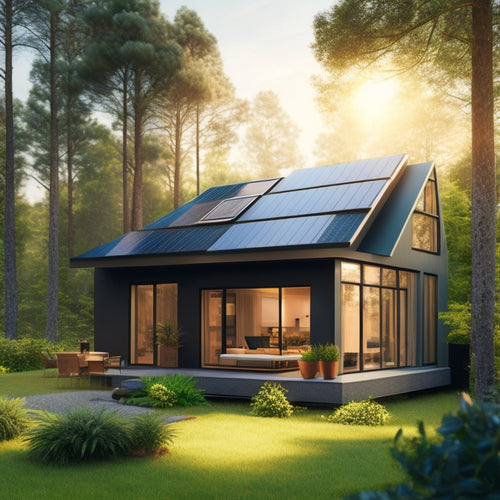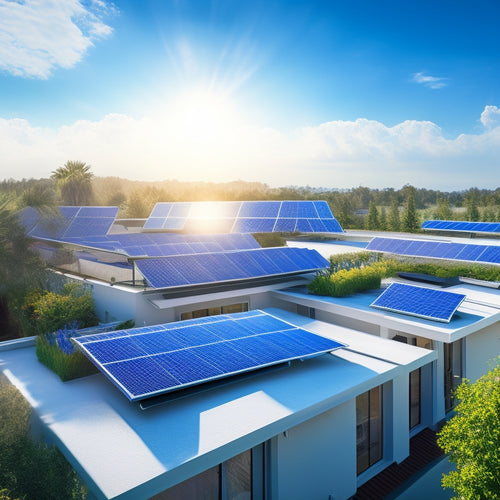
7 Steps to Industrial Solar Implementation
Share
You're about to commence a strategic expedition to tap into the power of industrial solar energy. To get started, you'll need to assess your energy consumption needs, evaluating your facility's energy requirements and identifying opportunities for efficiency improvements. Next, evaluate industrial solar options, considering upfront costs, financing strategies, and tax incentives. Conduct a site feasibility study to determine your site's suitability for solar technology. Then, design an optimized solar system, obtaining necessary permits, and selecting a reputable installer. Finally, prioritize ongoing maintenance and energy yield analysis to guarantee your system operates at peak performance. As you traverse these 7 critical steps, you'll reveal the key to discovering significant energy savings and a reduced carbon footprint.
Key Takeaways
- Assess energy needs and site feasibility to identify ideal solar solutions and opportunities for energy efficiency improvements.
- Evaluate solar options and financial considerations, including upfront costs, financing strategies, and tax incentives to ensure a viable project.
- Design and optimize solar systems to meet specific energy requirements, considering panel tilt, orientation, and shading mitigation strategies.
- Obtain necessary permits and ensure regulatory compliance by familiarizing with local, state, and federal regulations, and submitting detailed project plans.
- Select reputable installers and plan for ongoing maintenance, including regular inspections, performance monitoring, and routine tasks to ensure optimal system performance.
Assessing Energy Consumption Needs
When evaluating industrial solar implementation, analyzing energy consumption needs is a critical first step. You must understand your facility's energy requirements to determine the ideal solar solution. This involves examining your energy usage patterns, peak demand periods, and overall energy efficiency.
By doing so, you'll identify areas where energy efficiency improvements can be made, potentially reducing your energy consumption and increasing cost savings.
Conducting an energy audit will help you gather the necessary data to make informed decisions. This audit should include a thorough review of your facility's energy usage history, equipment efficiency, and operational practices.
You may also want to think about installing meters or submeters to track energy usage in specific areas or departments. With this data, you can pinpoint opportunities to enhance energy efficiency, reduce energy waste, and maximize cost savings through industrial solar implementation.
Evaluating Industrial Solar Options
Several industrial solar options are available to help you achieve your energy goals, and selecting the right one for your facility is essential.
You'll need to evaluate each option based on your specific needs and constraints. Start by conducting a cost comparison of different solar technologies, such as photovoltaic (PV) systems, concentrated solar power (CSP), and solar thermal systems.
Consider the upfront costs, operating expenses, and potential revenue streams from selling excess energy back to the grid.
Next, investigate financing options that align with your budget and goals. You may consider purchasing the system outright, securing a loan, or entering into a power purchase agreement (PPA) with a third-party provider.
Weigh the pros and cons of each financing option carefully, considering factors such as ownership, maintenance responsibilities, and potential tax benefits.
Conducting Site Feasibility Studies
You'll need to conduct a thorough site feasibility study to determine if your industrial site is suitable for solar implementation.
This study will consist of a solar site assessment to identify potential installation areas, a land use evaluation to guarantee compliance with local regulations, and an energy yield analysis to predict the system's performance.
Solar Site Assessment
Conducting a thorough solar site assessment is vital to determine the feasibility of a potential solar project. You'll need to evaluate the site's suitability for solar technology, considering factors that impact energy production and environmental impact. This involves analyzing the site's topography, including slope, orientation, and shading.
You'll also need to assess the local climate, including temperature, humidity, and solar irradiance, to determine the site's energy generation potential. During the site assessment, you'll inspect the site's infrastructure, including existing electrical infrastructure, buildings, and roads. This will help you identify potential challenges and opportunities for integrating solar technology into the existing infrastructure.
Additionally, you'll need to evaluate the site's environmental conditions, including flood zones, wetlands, and protected habitats, to ascertain that the solar project won't harm the local ecosystem. By conducting a thorough solar site assessment, you'll be able to determine whether the site is suitable for a solar installation and identify potential risks and opportunities.
This critical step will help you make informed decisions about your solar project and guarantee its success.
Land Use Evaluation
During the solar site evaluation, an essential step involves examining the land use feasibility of the proposed solar project. You'll need to determine whether the chosen site is suitable for industrial-scale solar development. This involves assessing various factors that can impact the project's success.
Some key considerations include:
-
Land zoning and regulatory compliance: Verify the site is zoned for industrial use and complies with local regulations.
-
Environmental impact and ecological considerations: Analyze the potential environmental effects of the project, such as habitat disruption or water usage, and consider measures to mitigate them.
-
Resource availability and site accessibility: Confirm the site has access to necessary resources, including roads, water, and electricity, and is accessible for construction and maintenance.
- Community engagement and financial incentives: Engage with local stakeholders to address concerns and investigate potential financial incentives, such as tax credits or grants, that can support the project's development.
Energy Yield Analysis
By this stage of the solar site evaluation, the focus shifts to evaluating the project's energy yield potential.
You're now tasked with conducting a thorough energy yield analysis to determine the feasibility of your industrial solar project. This involves examining the site's solar resource, system design, and energy production forecasting.
To achieve this, you'll need to gather and analyze data on various solar performance metrics, including irradiance, temperature, and humidity.
These metrics will help you understand the site's energy yield potential and identify any potential risks or opportunities.
You'll also need to take into account the system's design and configuration, including the type and orientation of solar panels, inverter efficiency, and tracking systems.
Designing Industrial Solar Systems
Your industrial solar system's performance hinges on a well-designed layout, which is why careful planning is vital. A well-planned system guarantees maximum energy yield, reduces installation costs, and optimizes system integration.
It's essential to take into account factors such as available roof space, energy consumption patterns, and local building codes to guarantee a seamless integration with your existing infrastructure.
To get the design right, take into account the following key aspects:
-
System Sizing: Determine the ideal system size based on your energy requirements and available space.
-
Array Configuration: Optimize the array layout to minimize shading, reduce electrical losses, and guarantee easy maintenance.
-
Inverter Selection: Choose the right inverter type and size to guarantee efficient energy conversion and maximize financial incentives.
- Monitoring and Control: Implement a sturdy monitoring and control system to track performance, identify issues, and optimize energy production.
Obtaining Necessary Permits
How do you guarantee that your industrial solar project complies with all applicable laws and regulations? Obtaining necessary permits is a vital step in confirming your project's legitimacy and avoiding costly delays.
You'll need to identify the required permit types, which vary depending on your project's location, size, and complexity. These may include building permits, electrical permits, and environmental permits.
Familiarize yourself with local, state, and federal regulations to determine the specific permits required for your project. The application process typically involves submitting detailed project plans, including engineering designs and environmental impact assessments.
Be prepared to provide documentation on your project's compliance with relevant building codes, safety standards, and environmental regulations. You may need to pay permit fees, which can vary considerably depending on the jurisdiction and project scope.
It's essential to plan ahead, as the permit application process can be time-consuming. Make sure you allocate sufficient time and resources to secure all necessary permits before commencing construction.
Installing Industrial Solar Panels
Installing industrial solar panels requires careful planning and execution to guarantee a safe and efficient operation.
You've secured the necessary permits, and now it's time to bring your industrial solar project to life. This involves selecting a reputable installer, confirming compliance with local building codes, and optimizing panel placement for maximum energy yield.
When installing industrial solar panels, consider the following key factors:
-
Financing options: Investigate available financing options, such as power purchase agreements (PPAs) or solar loans, to minimize upfront costs and maximize ROI.
-
Tax incentives: Take advantage of federal and state tax incentives, such as the Solar Investment Tax Credit (ITC), to reduce your tax liability and increase savings.
-
System design: Verify your system is designed to meet your specific energy needs, incorporating factors like panel tilt, orientation, and shading mitigation.
- Grid connection: Confirm a seamless grid connection, including compliance with utility interconnection requirements and net metering agreements.
Ongoing System Maintenance
Enhancing your industrial solar panel system's performance over its lifespan requires a proactive approach to ongoing system maintenance.
You'll need to regularly inspect and clean your panels to guarantee maximum energy output. Performance monitoring is critical to identifying potential issues before they become major problems. This involves tracking key performance indicators such as energy production, temperature, and voltage. By analyzing this data, you can pinpoint areas for improvement and optimize your system's performance.
Regular maintenance also involves performing routine tasks like tightening connections, replacing worn-out parts, and updating software.
Additionally, you should budget for system upgrades to keep your technology current and take advantage of efficiency gains. Upgrades can include replacing inverters, adding energy storage systems, or integrating new monitoring platforms.
Frequently Asked Questions
Can Industrial Solar Panels Be Installed on Rooftops With Skylights?
You can install industrial solar panels on rooftops with skylights, but you'll need to take into account rooftop considerations, such as structural integrity and weight capacity, and make skylight modifications to guarantee a secure and efficient installation that maximizes energy output.
Are There Financing Options for Industrial Solar Implementation?
You'll find various financing models for industrial solar implementation, including lease agreements, that can help you overcome upfront costs; for instance, you can opt for a power purchase agreement or a property-assessed clean energy financing model.
How Do I Ensure System Compliance With Industry Regulations?
You guarantee system compliance with industry regulations by familiarizing yourself with relevant regulatory standards and conducting regular compliance audits to identify and rectify any deviations, guaranteeing your system meets stringent industry requirements.
Can Industrial Solar Systems Be Integrated With Energy Storage?
You can integrate industrial solar systems with energy storage to optimize energy efficiency and enhance grid stability, allowing you to store excess energy generated during the day for use during peak hours or power outages.
Are There Any Tax Benefits for Industrial Solar Adoption?
As you shine a light on industrial solar adoption, you'll uncover a wealth of tax benefits, including lucrative incentives and solar credits that can greatly reduce your project's upfront costs, yielding a brighter bottom line for your business.
Related Posts
-

5 Essential Tips for Buying EV Charging Systems Online
When purchasing an EV charging system online, you'll want to make sure you're making an informed decision. First, det...
-

Reduce Solar Panel Cost for Your Small Home
By evaluating your energy needs, choosing the right installer, and selecting cost-effective solar panel options, you ...
-

Best Solar Panel Options for Maximum Energy Savings
You can maximize your energy savings with solar panels that boast efficiency ratings above 20%, paired with extensive...


